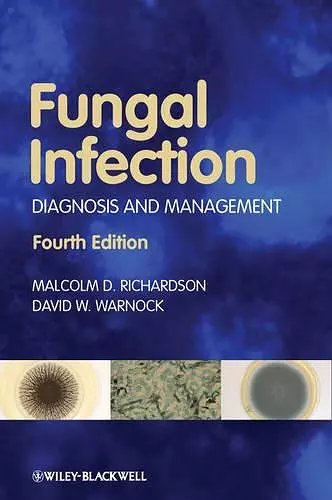Fungal Infection
Diagnosis and Management
Malcolm D Richardson author David W Warnock author
Format:Paperback
Publisher:John Wiley and Sons Ltd
Published:20th Feb '12
Currently unavailable, and unfortunately no date known when it will be back

Fungal Infection: Diagnosis and Management, 4th Edition is a concise and up-to-date guide to the clinical manifestations, laboratory diagnosis and management of superficial, subcutaneous and systemic fungal infections.
This highly acclaimed book has been extensively revised and updated throughout to ensure all drug and dosage recommendations are accurate and in agreement with current guidelines. A new chapter on infections caused by Pneumocystis jirovecii has been added. The book has been designed to enable rapid information retrieval and to help clinicians make informed decisions about diagnosis and patient management. Each chapter concludes with a list of recent key publications which have been carefully selected to facilitate efficient access to further information on specific aspects of fungal infections.
Clinical microbiologists, infectious disease specialists, as well as dermatologists, hematologists and oncologists, can depend on this contemporary text for authoritative information and the background necessary to understand fungal infections.
The third edition of this book has never been far away from my office phone and is now quite tatty, so I am delighted to review the new fourth edition, written by the same two experts. This book is an easy but detailed guide to fungal infections, ranging from those seen regularly by clinical microbiologists and infectious diseases specialists, such as Candida and Aspergillus, to exotic diseases seen only outside the UK such as Pythiosis. The emphasis of the book is on clinical presentation, specimen collection, interpretation of laboratory findings and management of the patient.
The new edition is a little larger than the previous one, but will still sit nicely on the desk. It has the same 27 chapters, most of which have been extensively revised and some new ones substituted. The chapters are based around clinical syndromes so, for example, there is quite a long chapter on dermatophyte infections and a shorter one on mycetoma. The chapter on antifungal drugs is much longer due to the addition of agents such as posaconazole and the newer echinocandins. New chapters have been added on Pneumocystosis, and ‘Unusual fungi and Pseudofungal infections’. At the end of each chapter is a useful guide to further reading.
Each chapter has a set of standard headings: definition, geographical distribution, causal organisms and habitat, epidemiology, clinical manifestations, differential diagnosis, essential investigations and their interpretation, management, prevention. This, coupled with the detailed index, makes it easy to find the bit of information you need. In particular, I found the chapter on histoplasma most helpful when working on an online clinical interpretation scenario!
As the authors say in the introduction, there have been a number of significant developments in the diagnosis and management of fungal infections since the last edition. Patients are now more complex by nature of their illness or their medical management, and the potential for opportunistic infection in the immunosuppressed has increased. Although the book was published in 2012, the basics of fungal infection such as microscopy and culture do not change. The extended chapter on laboratory diagnosis covers new techniques in serology and molecular diagnosis. At the moment, there is a lack of rapid and cost-effective tests in this area; many of the assays being performed are not standardised and some more trials are needed. I hope this section will be the one that goes out of date first, as more rapid or molecular tests are added to the diagnostic setting.
I will keep this book on my desk as quick reference during a phone call, but also as a more detailed guide to managing patients with invasive fungal infections. I recommend it to anyone who deals with fungal infections, whether in the laboratory or out on the wards, and to trainees and students as well. (Dr Fiona E. Donald, Consultant Medical Microbiologist, Nottingham University Hospitals, RCPATH Bulletin, October 2013)
ISBN: 9781405170567
Dimensions: 229mm x 152mm x 21mm
Weight: 608g
480 pages
4th edition